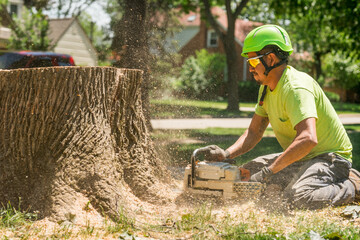One of the key challenges you encounter after removing a tree is stump removal, which presents a decision between handling the task yourself or hiring professionals.
Each choice has its advantages and disadvantages.
Once the stump is cleared, preparing your land for restoration becomes the next critical step.
It’s important to familiarize yourself with the best practices for revitalizing your property to truly enhance your landscape.
Let’s explore the various approaches that can unlock your landscape’s full potential.
Stump Removal Methods: DIY vs. Professional Services
Choosing between DIY and professional stump removal depends on various factors.
DIY Stump Removal
Pros:
- Cost-Effective: Potentially the most budget-friendly option.
- Sense of Accomplishment: It can be a rewarding DIY project.
Cons:
- Time-Consuming: This can be labor-intensive and time-consuming, especially for larger stumps.
- Requires Physical Effort: This can be physically demanding, requiring digging, chopping, and potentially heavy lifting.
- Safety Risks: Potential for injury if not done correctly.
- Requires Specialized Tools: You may need to rent or purchase specialized tools, such as axes, shovels, grinders, and stump grinders.
- Environmental Impact: Some methods can damage surrounding plants and soil.
Professional Stump Removal
Pros:
- Efficient and Quick: Professionals have the expertise and equipment to remove stumps quickly and efficiently.
- Safe and Reliable: Minimizes the risk of injury and ensures proper safety procedures are followed.
- Less Physically Demanding: Eliminates the need for heavy lifting and strenuous physical labor.
- Environmentally Friendly: Many professionals use environmentally friendly methods that minimize damage to surrounding areas.
Cons:
- Costly: Professional services can be expensive, especially for larger stumps.
Factors to Consider
When deciding between DIY and professional stump removal, consider the following factors:
- Size of the Stump: Smaller stumps may be easier to remove DIY, while larger stumps are often best left to professionals.
- Your Physical Abilities: If you have any physical limitations, hiring a professional is likely safer and more practical.
- Time Constraints: If you need the stump removed quickly, hiring a professional is faster and more efficient.
- Budget: Consider your budget and weigh the DIY tools and equipment costs against hiring a professional.
- Environmental Concerns: If you’re concerned about the ecological impact, inquire about the methods used by DIY and professional stump removal services.
Ultimately, the best decision depends on your circumstances, preferences, and budget.
Preparing Your Land for Restoration
After stump removal, proper land preparation is essential for successful restoration.
Assess the Site:
- Soil Condition: Carefully examine the soil for compaction, debris, and any remaining roots.
- Soil pH: Test the soil pH level to determine the suitability for different plants.
Clear the Area:
- Remove any remaining roots, wood chips, or debris from the stump removal process.
Improve Soil Health:
- Aeration: If the soil is compacted, aerate it to improve water and nutrient absorption.
- Soil Amendments: Consider adding organic matter such as compost to improve soil structure and fertility.
Address Drainage Issues:
- Ensure proper drainage to prevent waterlogging, which can hinder plant growth.
By carefully preparing your land, you create a healthy foundation for successful restoration and the growth of new plants.
Tips for Effective Landscaping After Stump Removal
Once you’ve prepared the area where the stump was removed, you can begin to plan your new landscape. Here are some tips for effective landscaping:
Fill and Level:
- Fill the Hole: Fill the hole left by the stump removal with quality topsoil.
- Level the Surface: Ensure the area is level to prevent water pooling and to ensure proper drainage.
Choose the Right Plants:
- Native Plants: Consider planting native grasses, flowers, and shrubs. They are well-adapted to your local climate, require less maintenance, and support local biodiversity.
- Ornamental Plants: Add visual interest with ornamental plants such as flowering shrubs, small trees, or perennials.
Enhance the Area:
- Mulching: Apply a layer of mulch around new plants to retain moisture, suppress weeds, and regulate soil temperature.
- Create Features: To enhance the space, consider adding features such as a small garden, a seating area, or a water feature.
Ongoing Care:
- Watering: Water new plantings regularly, especially during dry periods.
- Maintenance: Provide ongoing care, such as weeding, fertilizing, and pruning, to ensure the health and vitality of your new landscape.
Following these tips, you can transform the area where the stump was removed into a beautiful and functional part of your landscape.
Successful stump removal and subsequent land restoration require careful planning and execution.
By carefully considering your options for stump removal, whether DIY or professional and implementing effective land preparation techniques, you can create a thriving and aesthetically pleasing landscape.
Remember to prioritize soil health, choose the right plants, and provide ongoing care to ensure the long-term success of your restoration efforts.

